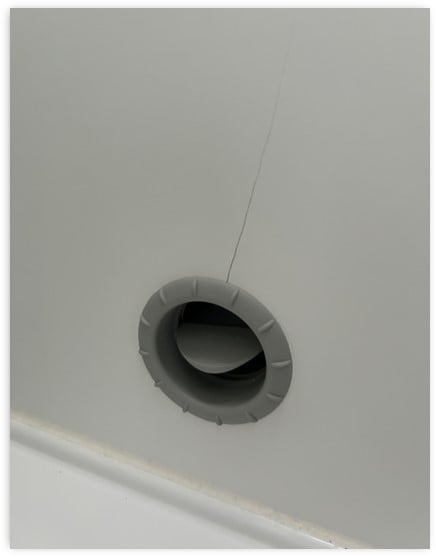This post contains affiliate links
In September we had our Grand California loaded up from 3.5 to 4.1 tons. The reasons were obvious, we just had a payload of around 350 kilos. That was simply unrealistic and we just couldn’t live with that payload, or rather we couldn’t keep to it.
If you would like to know how the uplift went, you are welcome to read about it again HERE
You can see this post as an addendum to the loading topic above, because we ran across a totally important point.
Mandatory warning lights for vehicles over 3.5 tons
What we didn’t know is, motor vehicles that weigh more than 3.5 tons must carry a warning light. Sure you know somehow you need a warning triangle and a first aid kit, but a lamp!? Of course you can ask yourself at this point what is different about the Grand California and why the same car with 3.5 tons does not need such a lamp, but the law is the law (StVZO §53a) and in this is written the following:
(2) Motor vehicles other than ambulances, motorcycles, and single-axle tractors or work machines must carry at least the following warning devices:
StVZO
- In passenger cars, agricultural or forestry tractors or working machines and in other motor vehicles with a permissible total weight of not more than 3.5 t: a warning triangle;
- In motor vehicles with a permissible total weight of more than 3.5 t: a warning triangle and, separately, a warning light. A portable flashing light in accordance with § 53b (5) sentence 7 may also be carried as a warning light;
- In passenger cars, trucks, tractor units, semitrailer tractors and buses: a high-visibility vest.
So there it is, the crucial phrase: “In motor vehicles with a gross vehicle weight rating of more than 3.5 tons: a warning triangle and, separately, a warning light.”
Of course, you can’t take any flashing light with you now and say in a control: Tada, here’s my warning light. 😅 Careful, these lamps must meet the requirements of the StVZO:
(1) Warning triangles and warning lights must be portable, stable and designed so that they can be seen at a sufficient distance when in use. Warning triangles must be reflective; warning lights must emit flashing yellow light, be independent of the vehicle’s lighting system, and have sufficient burning time. High visibility vests must comply with the standard DIN EN 471:2003+A1:2007, March 2008 edition or with the standard EN ISO 20471:2013.
Important: pay attention to approval for the warning lamp
Sollet you now as we have noticed, crap, so no thing we do not have in the car, then please make sure when ordering that the warning lamp according to §53a para. 1 is permitted.

We opted for an inexpensive variant from Leina Werke. You can get this model for around 29 Euros, among others at Amazon.
Order ex works
The fact that our Grand California did not come with a warning light from Volkswagen makes perfect sense, because as described above, the vehicle was a 3.5 tonner when delivered. But VWN takes the cake with the fact that even the 3.88 ton Grand California is delivered without this mandatory lamp.
This can be ordered as an optional extra and is charged at 40 euros.

I would expect such a part to be included. After all, the vehicle also has tail lights, for example, which are mandatory. But to further optimize the margin, it of course makes perfect sense to save on this part. VWN also manages to flush a little extra cash into the coffers for tire pressure monitoring, which is only mandatory for passenger cars.
From 4 tons there is a little more to consider
If your Grand California now weighs more than 4 tons, there is something else you need to consider. This is because vehicles with a total mass of over 4 tons are required to carry a wheel chock.
Of course, this is also precisely regulated in the StVZO, paragraph 41 only deals with the subject of brakes and wheel chocks. The corresponding passage can be found under paragraph 14 where it says:
“(14) The motor vehicles and trailers listed below shall be equipped with wheel chocks.”. Required are at least
1.
a wheel chock at
a)
Motor vehicles – except track vehicles – with a permissible total weight of more than 4 t,
b)
two-axle trailers – excluding semi-trailers and rigid drawbar trailers (including center-axle trailers) – with a gross vehicle weight of more than 750 kg,
2.
two wheel chocks with
a)
three-axle and multi-axle vehicles,
b)
Semi-trailers,
c)
Rigid drawbar trailers (including center axle trailers) with a gross vehicle weight of more than 750 kg.
Chocks must be safe to handle and sufficiently effective. They must be mounted in or on the vehicle in an easily accessible manner with brackets that preclude loss and rattling. Hooks or chains shall not be used as supports.”
Thus, it is clear that you need a wedge from 4 tons. There are various designs and variants here, but we wouldn’t be in Germany if there weren’t requirements for a wedge. The wedge of your choice must therefore comply with DIN 76051.
You can find a complete overview of the wedges available for purchase on Amazon HERE.

If you own a Grand California with 3.88 tons, you should take a look under the flap of the fresh water tank, there you will find a strange metal frame. If you’ve already spotted this and always wondered what it was, properly the holder for the wedge. Why this little extra is only mounted in the 3.88 tonner, probably also remains the secret of VWN. So, should you decide to upsize, you’ve already found the perfect mount for the necessary wedge.
So remember your light and wedge if necessary and save yourself a fine. Especially abroad, where these are also mandatory, it can be really expensive without.



